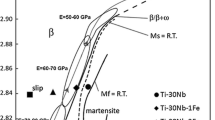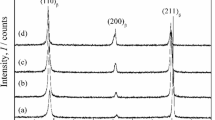Abstract
Among many β-metastable alloys explored for biomedical applications, alloys from the Ti-Nb-Fe-Zr system present great potential regarding cost and mechanical strength. In this article, we take a new look at the possibility of using Fe as a minor alloying element in the Ti-Nb-Fe-Zr system, with additions up to 2.0 wt% Fe. Additional compositions fixing the Nb/Fe ratio and changing Zr content from 7–13 wt% were also explored, resulting in a total of five different alloys. The samples were solution-treated and then subjected to three different conditions: water-quenched, furnace-cooled, and step-quenched to 450 ºC for 12 h. Resultant microstructures were analyzed using X-ray diffraction, differential scanning calorimetry, scanning, and transmission electron microscopy. DSC experiments indicate that Zr might alter the phase transformations that occur during heating and cooling cycles. First-principles calculations confirmed that Zr's addition is crucial to reduce the elastic modulus of the β matrix and increase the ω-phase formation energy relative to β. All alloys presented mechanical properties suitable for biomedical applications; however, Ti-23Nb-2.0Fe-10Zr (wt %) stands out with the best combination of mechanical strength and elastic modulus after aging.
Graphical abstract














Similar content being viewed by others
References
Marvel CJ, Sabol JC, Pasang T et al (2017) Improving the mechanical properties of the fusion zone in electron-beam welded Ti-5Al-5Mo-5V-3Cr Alloys. Metall Mater Trans A 48:1921–1930. https://doi.org/10.1007/s11661-017-3968-2
Kolli R, Devaraj A (2018) A review of metastable beta titanium alloys. Metals (Basel) 8:506. https://doi.org/10.3390/met8070506
Devaraj A, Joshi VV, Srivastava A et al (2016) A low-cost hierarchical nanostructured beta-titanium alloy with high strength. Nat Commun 7:11176. https://doi.org/10.1038/ncomms11176
Franti GW, Williams JC, Aaronson HI (1978) A survey of eutectoid decomposition in ten Ti-X systems. Metall Trans A 9:1641–1649. https://doi.org/10.1007/BF02661947
Lee HJ, Aaronson HI (1988) Eutectoid decomposition mechanisms in hypoeutectoid Ti-X alloys. J Mater Sci 23:150–160. https://doi.org/10.1007/BF01174047
Nag S, Banerjee R, Fraser HL (2005) Microstructural evolution and strengthening mechanisms in Ti-Nb-Zr-Ta, Ti-Mo-Zr-Fe and Ti-15Mo biocompatible alloys. Mater Sci Eng C 25:357–362. https://doi.org/10.1016/j.msec.2004.12.013
ASTM International (2013) Standard Specification for Wrought Titanium-12Molybdenum-6Zirconium-2Iron Alloy for Surgical Implant (UNS R58120). https://doi.org/10.1520/F1813-13.2
Lee CM, Ho WF, Ju CP, Chern Lin JH (2002) Structure and properties of Titanium-25 Niobium-x iron alloys. J Mater Sci Mater Med 13:695–700
Hsu H-C, Hsu S-K, Wu S-C et al (2010) Structure and mechanical properties of as-cast Ti–5Nb–xFe alloys. Mater Charact 61:851–858. https://doi.org/10.1016/j.matchar.2010.05.003
Lopes ÉSN, Salvador CAF, Andrade DR et al (2016) Microstructure, mechanical properties, and electrochemical behavior of Ti-Nb-Fe alloys applied as biomaterials. Metall Mater Trans A 47:3213–3226. https://doi.org/10.1007/s11661-016-3411-0
Cui WF, Guo AH (2009) Microstructures and properties of biomedical TiNbZrFe β-titanium alloy under aging conditions. Mater Sci Eng A 527:258–262. https://doi.org/10.1016/j.msea.2009.08.057
Xue P, Li Y, Li K et al (2015) Superelasticity, corrosion resistance and biocompatibility of the Ti-19Zr-10Nb-1Fe alloy. Mater Sci Eng C 50:179–186. https://doi.org/10.1016/j.msec.2015.02.004
Nocivin A, Cinca I, Raducanu D et al (2017) Mechanical properties of a Gum-type Ti–Nb–Zr–Fe–O alloy. Int J Miner Metall Mater 24:909–917. https://doi.org/10.1007/s12613-017-1477-3
Dal Bó MR, Salvador CAF, Mello MG et al (2018) The effect of Zr and Sn additions on the microstructure of Ti-Nb-Fe gum metals with high elastic admissible strain. Mater Des 160:1186–1195. https://doi.org/10.1016/j.matdes.2018.10.040
Esteban PG, Ruiz-Navas EM, Gordo E (2010) Influence of Fe content and particle size the on the processing and mechanical properties of low-cost Ti–xFe alloys. Mater Sci Eng A 527:5664–5669. https://doi.org/10.1016/j.msea.2010.05.026
Kent D, Pas S, Zhu S et al (2012) Thermal analysis of precipitation reactions in a Ti–25Nb–3Mo–3Zr–2Sn alloy. Appl Phys A 107:835–841. https://doi.org/10.1007/s00339-012-6778-9
Kresse G, Furthmiiller J (1996) Efficiency of ab-initio total energy calculations for metals and semiconductors using a plane-wave basis set av *. Comput Mater Sci 6:15–50
Van De Walle A, Tiwary P, De Jong M et al (2013) Efficient stochastic generation of special quasirandom structures. Calphad 42:13–18. https://doi.org/10.1016/j.calphad.2013.06.006
Von Pezold J, Dick A, Friák M, Neugebauer J (2010) Generation and performance of special quasirandom structures for studying the elastic properties of random alloys: Application to Al-Ti. Phys Rev B-Condens Matter Mater Phys 81:1–7. https://doi.org/10.1103/PhysRevB.81.094203
Gaillac R, Pullumbi P, Coudert FX (2016) ELATE: An open-source online application for analysis and visualization of elastic tensors. J Phys Condens Matter. https://doi.org/10.1088/0953-8984/28/27/275201
Momma K, Izumi F (2008) VESTA: A three-dimensional visualization system for electronic and structural analysis. J Appl Crystallogr 41:653–658. https://doi.org/10.1107/S0021889808012016
Todd R, Armstrong D (2006) Gum metal and related alloys. In: Encyclopedia of materials: science and technology. Elsevier, Amsterdam, pp 1–4. https://doi.org/10.1016/B978-0-12-803581-8.11538-3
Saito T, Furuta T, Hwang J-H et al (2003) Multifunctional alloys obtained via a dislocation-free plastic deformation mechanism. Science 300:464–467. https://doi.org/10.1126/science.1081957
Cotton JD, Briggs RD, Boyer RR et al (2015) State of the art in beta titanium alloys for airframe applications. JOM 67:1281–1303. https://doi.org/10.1007/s11837-015-1442-4
da Costa FHFH, Salvador CAFCAF, de Mello MGMG, Caram R (2016) Alpha phase precipitation in Ti-30Nb-1Fe alloys–phase transformations in continuous heating and aging heat treatments. Mater Sci Eng A 677:222–229. https://doi.org/10.1016/j.msea.2016.09.023
Salvador CAFF, Lopes ESNN, Caram R et al (2017) Solute lean Ti-Nb-Fe alloys: an exploratory study. J Mech Behav Biomed Mater 65:761–769. https://doi.org/10.1016/j.jmbbm.2016.09.024
Banerjee D, Williams JC (2013) Perspectives on titanium science and technology. Acta Mater 61:844–879. https://doi.org/10.1016/j.actamat.2012.10.043
Salvador CAF, Opini VC, Lopes ESN, Caram R (2017) Microstructure evolution of Ti–30Nb–(4Sn) alloys during classical and step-quench aging heat treatments. Mater Sci Technol 33:400–407. https://doi.org/10.1080/02670836.2016.1216030
Ozan S, Lin J, Li Y et al (2015) Development of Ti–Nb–Zr alloys with high elastic admissible strain for temporary orthopedic devices. Acta Biomater 20:176–187. https://doi.org/10.1016/j.actbio.2015.03.023
Min XH, Emura S, Zhang L, Tsuzaki K (2008) Effect of Fe and Zr additions on ω phase formation in β-type Ti–Mo alloys. Mater Sci Eng A 497:74–78. https://doi.org/10.1016/j.msea.2008.06.018
Banerjee R, Nag S, Stechschulte J, Fraser HL (2004) Strengthening mechanisms in Ti–Nb–Zr–Ta and Ti–Mo–Zr–Fe orthopaedic alloys. Biomaterials 25:3413–3419. https://doi.org/10.1016/j.biomaterials.2003.10.041
Dobromyslov AV, Elkin VA (2001) Martensitic transformation and metastable beta-phase in binary titanium alloys with d-metals of 4–6 periods. Scr Mater 44:905–910
Fu Y, Xiao W, Wang J et al (2020) Oxygen induced crystal structure transition of martensite in Ti–Nb–Fe alloys. Mater Lett 262:127026. https://doi.org/10.1016/j.matlet.2019.127026
Opini VC, Salvador CAF, Campo KN et al (2016) α phase precipitation and mechanical properties of Nb-modified Ti-5553 alloy. Mater Sci Eng A 670:112–121. https://doi.org/10.1016/j.msea.2016.06.001
Choudhuri D, Zheng Y, Alam T et al (2017) Coupled experimental and computational investigation of omega phase evolution in a high misfit titanium-vanadium alloy. Acta Mater 130:215–228. https://doi.org/10.1016/j.actamat.2017.03.047
Li M, Min X (2020) Origin of ω-phase formation in metastable β-type Ti-Mo alloys: cluster structure and stacking fault. Sci Rep 10:8664. https://doi.org/10.1038/s41598-020-65254-z
Withey EA, Minor AM, Chrzan DC et al (2010) The deformation of gum metal through in situ compression of nanopillars. Acta Mater 58:2652–2665. https://doi.org/10.1016/j.actamat.2009.12.052
Gutierrez-Urrutia I, Li C-L, Emura S et al (2016) Study of {332}<113> twinning in a multilayered Ti-10Mo-xFe (x = 1–3) alloy by ECCI and EBSD. Sci Technol Adv Mater 17:220–228. https://doi.org/10.1080/14686996.2016.1177439
Gorsse S, Hutchinson C, Gouné M, Banerjee R (2017) Additive manufacturing of metals: a brief review of the characteristic microstructures and properties of steels, Ti-6Al-4V and high-entropy alloys. Sci Technol Adv Mater 18:584–610. https://doi.org/10.1080/14686996.2017.1361305
Van Stone RH, Low JR, Shannon JL (1978) Investigation of the fracture mechanism of Ti-5AI-2.5 Sn at cryogenic temperatures. Metall Trans A 9:539–552
Salvador CAF, Opini VC, Mello MG, Caram R (2018) Effects of double-aging heat-treatments on the microstructure and mechanical behavior of an Nb-modified Ti-5553 alloy. Mater Sci Eng A 743:716–725. https://doi.org/10.1016/j.msea.2018.11.086
Biesiekierski A, Lin J, Li Y et al (2016) Investigations into Ti–(Nb, Ta)–Fe alloys for biomedical applications. Acta Biomater 32:336–347. https://doi.org/10.1016/j.actbio.2015.12.010
Wang X, Zhang L, Guo Z et al (2016) Study of low-modulus biomedical β Ti–Nb–Zr alloys based on single-crystal elastic constants modeling. J Mech Behav Biomed Mater 62:310–318. https://doi.org/10.1016/j.jmbbm.2016.04.040
Talling RJ, Dashwood RJ, Jackson M, Dye D (2009) Compositional variability in gum metal. Scr Mater 60:1000–1003. https://doi.org/10.1016/j.scriptamat.2009.02.044
Abdel-Hady M, Hinoshita K, Morinaga M (2006) General approach to phase stability and elastic properties of β-type Ti-alloys using electronic parameters. Scr Mater 55:477–480. https://doi.org/10.1016/j.scriptamat.2006.04.022
Abdel-Hady M, Fuwa H, Hinoshita K et al (2007) Phase stability change with Zr content in β-type Ti–Nb alloys. Scr Mater 57:1000–1003. https://doi.org/10.1016/j.scriptamat.2007.08.003
Majumdar P, Singh SB, Chakraborty M (2011) The role of heat treatment on microstructure and mechanical properties of Ti–13Zr–13Nb alloy for biomedical load bearing applications. J Mech Behav Biomed Mater 4:1132–1144. https://doi.org/10.1016/j.jmbbm.2011.03.023
Biesiekierski A, Lin J, Li Y et al (2016) Investigations into Ti-(Nb, Ta)-Fe alloys for biomedical applications. Acta Biomater 32:336–347. https://doi.org/10.1016/j.actbio.2015.12.010
Gepreel MA, Niinomi M, Abdel-Hady Gepreel M et al (2013) Biocompatibility of Ti-alloys for long-term implantation. J Mech Behav Biomed Mater 20:407–415. https://doi.org/10.1016/j.jmbbm.2012.11.014
Acknowledgements
This work was supported by FAPESP (Sao Paulo Research Foundation, Grant 2014/24449-0) and CNPq (Brazilian National Council for Scientific and Technological Development, Grant 155650/2018-1). The authors would like to acknowledge the LNNano/CNPEM/Brazil for technical support during the electron microscopy work. The authors thank CBMM for providing the niobium used in this work.
Author information
Authors and Affiliations
Corresponding author
Ethics declarations
Conflict of interest
The authors declare that there is no conflict of interest.
Additional information
Handling Editor: Sophie Primig.
Publisher's Note
Springer Nature remains neutral with regard to jurisdictional claims in published maps and institutional affiliations.
Rights and permissions
About this article
Cite this article
Salvador, C.A.F., Dal Bo, M.R., Lima, D.D. et al. Experimental and computational investigation of Ti-Nb-Fe-Zr alloys with limited Fe contents for biomedical applications. J Mater Sci 56, 11494–11510 (2021). https://doi.org/10.1007/s10853-021-06002-0
Received:
Accepted:
Published:
Issue Date:
DOI: https://doi.org/10.1007/s10853-021-06002-0




